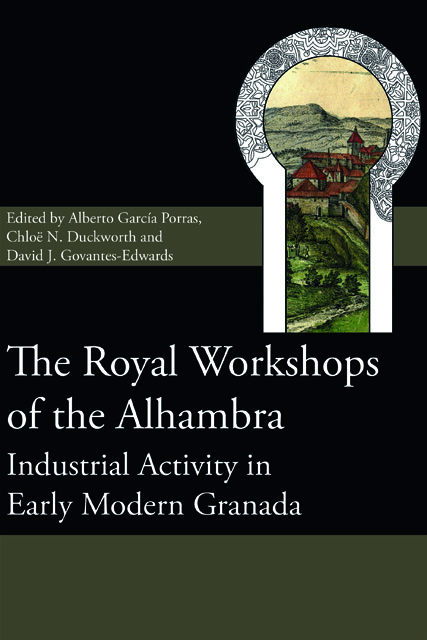Book contents
- Frontmatter
- Contents
- List of Illustrations
- List of Contributors
- Acknowledgements
- Foreword
- Introduction
- 1 The Secano: the city of the Alhambra
- 2 A holistic and reflexive methodology for the archaeological investigation of pyrotechnological activity in the Alhambra
- 3 The modern kilns
- 4 Geophysical and geochemical exploration of the industrial areas in the Alhambra
- 5 The excavation of the area of the Secano in the Alhambra: Trench 1
- 6 The excavation of the area of the Secano in the Alhambra: Trench 2
- 7 The pottery
- 8 Glass in the excavation of the Secano, the Alhambra
- 9 Furnaces at full blast: the demand for architectural ceramics for construction in the Alhambra (16th and 17th centuries)
- Conclusions
- Index
1 - The Secano: the city of the Alhambra
Published online by Cambridge University Press: 20 December 2023
- Frontmatter
- Contents
- List of Illustrations
- List of Contributors
- Acknowledgements
- Foreword
- Introduction
- 1 The Secano: the city of the Alhambra
- 2 A holistic and reflexive methodology for the archaeological investigation of pyrotechnological activity in the Alhambra
- 3 The modern kilns
- 4 Geophysical and geochemical exploration of the industrial areas in the Alhambra
- 5 The excavation of the area of the Secano in the Alhambra: Trench 1
- 6 The excavation of the area of the Secano in the Alhambra: Trench 2
- 7 The pottery
- 8 Glass in the excavation of the Secano, the Alhambra
- 9 Furnaces at full blast: the demand for architectural ceramics for construction in the Alhambra (16th and 17th centuries)
- Conclusions
- Index
Summary
One of the most prominent features of the Alhambra as an archaeological site is the fact that it remained ‘alive’ as a city within a city until relatively recently. This, along with the archaeological work carried out over the last century or so – which was sometimes very poorly documented, if documented at all – has resulted in an extraordinarily complex archaeological picture. However, unlike other urban sites, the Alhambra possesses a relatively rich archival record, which can be of great help in interpreting the archaeological sequence. Dating chiefly from the 16th and 18th centuries, these records provide precise descriptions of streets, alleys, and houses and bear witness to the transformations undergone by the madīna in the aftermath of the Christian conquest and the following centuries. This paper examines these records for the area of the Secano and pays special attention to the location of industrial establishments and workshops, which can also be illuminating concerning the organization of production in the Nasrid period and later, given the archaeological evidence of topographic continuity in the Secano.
Keywords: Early modern Spain, Post-Nasrid Granada, Palatial Cities, Pyrotechnologies, Archival Research
Palatine Cities in Islam
The study of the nature and evolution of palatine cities in Islam is no easy matter, and the issue has been paid little attention to date, collectively or individually; there are, however, some notable exceptions, among them the Alhambra. In general, the seat of power and the residence of the ruler were to undergo a radical transformation during the Middle Ages; the transition from the camp-cities of Kūfa, Baṣra, and Fusṭāṭ to the early palatine cities, such as Bagdād or Samarra, was swift. One of the reasons behind this quick evolution was the rapid growth of royal courts (especially the Abbasid), which over time demanded an ever greater range of services and personnel around the exercise of power.
These cities present a full urban scheme, although sometimes reduced to its most basic expression, owing to space limitations: perimeter wall; residential area for palace officials and guests; central mosque; baths, commercial and industrial area; and, of course, the palatial area itself.
The main function of these cities is, first and foremost, to display power – the power of the emir or sultan that inhabits it and the dynasty to which they belong. This function is clear in the first palace-city to have been built in al-Andalus, Madīnat al-Zahrā’.
- Type
- Chapter
- Information
- The Royal Workshops of the AlhambraIndustrial Activity in Early Modern Granada, pp. 7 - 16Publisher: Boydell & BrewerPrint publication year: 2022



